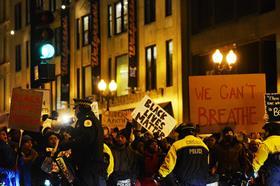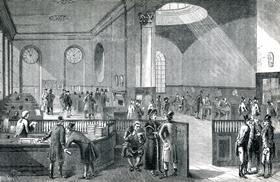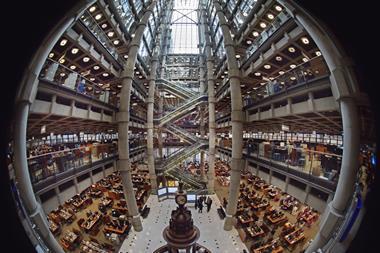Lloyd’s ’is holding its hand up and accepting responsibility for their involvement’, says chief executive
Sitting at the heart of the capital’s financial district is Lloyd’s of London, a marketplace well-known among those in the insurance industry given that it serves as a central hub for the global market.

While it may be less familiar to some outside of the industry, the discovery of historical ties between Lloyd’s and the transatlantic slave trade in 2020 brought about national attention.
It came following the Black Lives Matter movement, with the connection between the marketplace and transatlantic slave trade being unearthed through the University College London’s (UCL) Legacies of British Slave-Ownership project that summer.

The project brought to light figures who owned and profited from the transatlantic slave trade, such as Simon Fraser.
Fraser was a founding subscriber of Lloyd’s in 1771 and the proprietor of at least 162 enslaved individuals and oversaw the Castle Bruce estate, a sugar plantation in Dominica.
After the disclosure, Lloyd’s acknowledged its role as a “global centre” for insuring the ships involved in transporting an estimated 3.2m enslaved African individuals worldwide through the shipping industry from 1640 to the early 19th century.
It also issued a statement that apologised for its “shameful” history and vowed to redeem itself.
Three years later, Lloyd’s told Insurance Times that it had consulted “experts from academia, finance, and diversity and inclusion spaces” and had engaged with “hundreds of diverse colleagues” within the market to determine the “most appropriate and impactful approach” for addressing the institution’s historical ties to the transatlantic slave trade.
As part of this, on 8 November 2023, a video was uploaded to Lloyd’s website, which explored the historical connections to the transatlantic slave trade.
The video was part of the Underwriting Souls project, which came about from research conducted by Black Beyond Data at Johns Hopkins University.
In the video, Alexander White, the assistant professor at John Hopkins University that led the research, explained: “While the activities of insurers in the city of London may seem far removed from the plantations, ships and the violent spaces of imprisonment along the coast of Africa, the financial architecture and assessments developed at Lloyd’s helped maintain the institution of slavery.
“The insurance of ships, cargo and captured and enslaved persons, as well as the development of complex chains of credit, facilitated the growth of the transatlantic slave trade, particularly Britain’s role in it in the 18th and 19th centuries.
“London’s growth as a metropolis in the 17th, 18th and 19th centuries was built on the trade of enslaved people and also the goods that were produced from enslavement.”
Speaking to Insurance Times, David Flint, chief executive of Blue Mountain Capacity, noted that many heirs of inherited wealth may lack awareness or understanding of historical ties to the slave trade.
He highlighted that such a lack of awareness would be the reason why descendants of those who amassed wealth from the transatlantic slave trade may not understand the calls for reparations from the descendants of slaves.
However, he noted that Lloyds ”is holding its hand up and accepting responsibility for their involvement”.
He added: “Lloyds is saying, ‘we amassed millions during that era without much thought. We proceeded to construct large residences in both the countryside and London. Here and now, we recognise that our wealth was significantly influenced by the slave trade.’”
“It is a good demonstration because it might make other people think, ‘I can’t ignore the fact that a portion of my wealth and, the reason I am where I am today, is because a few hundred years ago, my family got rich owning slaves or being involved.’”
Call for reparations
However, to comprehend the demand for reparations in the 21st century, grasping the complexities of the past will be key.
Read: Insurance sector needs to ‘face into’ D&I challenges of recruitment
Read: Lloyd’s of London told of ‘crucial’ need to reflect on historical role in slave trade
Explore more diversity and inclusion-related articles here or discover other news stories here

The Legacies of British Slave-ownership project stated that, while Britain formally abolished the slave trade in 1807, the cessation faced opposition.
This resistance led to British slave owners persisting in deriving benefits from the trade, receiving compensation for what they deemed as their “losses”.
Lloyd’s Inclusive Futures research highlighted that Joseph Marryat, a former member of parliament who assumed the position of Lloyd’s chair in 1811, collaborated over this with Lloyd’s subscriber and slave owner Alexander Anderson and his brother John Anderson.
The latter coowned a slave castle in Sierra Leone and together they “wrote petitions against the abolition of the slave trade, which were presented before Parliament in 1807”.
The Legacies of British Slave-ownership project added that, in turn, the government compensated slave traders with £20m pounds for their perceived “losses.”
For example, Fraser was compensated £400,000 – in today’s money – for surrendering his estate in Dominica.
To fund the compensation, the government took out a loan in 1835, which was fully repaid using British taxpayers’ money in 2015.
This implied that contemporary UK taxpayers, including descendants of enslaved individuals, contributed money towards compensating slave traders and their descendants – leading to the call of reparations.
Flint said: “When people talk about reparations, they think ‘why should we pay now?’”
“It is about holding your hand up and saying, ’If I look back, the reason that I am privileged is because of my family’s involvement in the transatlantic slave trade.
“It is [thinking], as for someone who inherited wealth from the slave trade, is there something I can do now?”
Progress
The call for reparations has been a long and complicated journey that Lloyd’s has grappled with since 2020, with the insurance giant not able to pay reparations.
White explained that the material from the Underwriting Soul’s research, for example, “offered very little” about the people who were “captured and enslaved under the practices facilitated by the Lloyd’s market”.
Bruce Carnegie-Brown, chairman of Lloyd’s, added: “The documentation is extremely fragmented and so it is impossible to aggregate it into a number or even a range of numbers”.
He concluded that this could not be a full accounting of the fortunes made by its underwriters from slavery insurance through the centuries.
However, on 8 November 2023, Lloyd’s made a series of announcements that explained the steps it was taking to make up for its past.
For example, Lloyd’s introduced its new programme Inclusive Futures, which has been designed to support the career progression of black and ethnically diverse individuals.
“The initiatives we’ve announced are the product of those discussions, designed to deliver real, lasting change for those still affected by the legacy of slavery in the areas where we can have the most impact,” the marketplace added.
In turn, Lloyd’s hopes the programme will “deliver meaningful, sustainable change in building a more inclusive marketplace and society”.
As a further commitment, Lloyd’s also pledged to allocate £40m towards profit-making investments in the African Development Bank and the Inter-American Development Bank, particularly in support of programmes in the Caribbean.
“We’ll continue to be guided on this developing topic by the views of those who know and feel this history most keenly,” said Lloyd’s.
Flint added: “Lloyd’s actions set an example for other institutions to contemplate.”
He also noted that Lloyd’s initiatives might prompt reflection on the history of personal backgrounds and current circumstances.
Nevertheless, while Lloyd’s is taking action, the question is whether this is sufficient in the eyes of those who are descendants of those impacted by the transatlantic slave trade.
Hosted by comedian and actor Tom Allen, 34 Gold, 23 Silver and 22 Bronze awards were handed out across an amazing 34 categories recognising brilliance and innovation right across the breadth of UK general insurance.




















































No comments yet